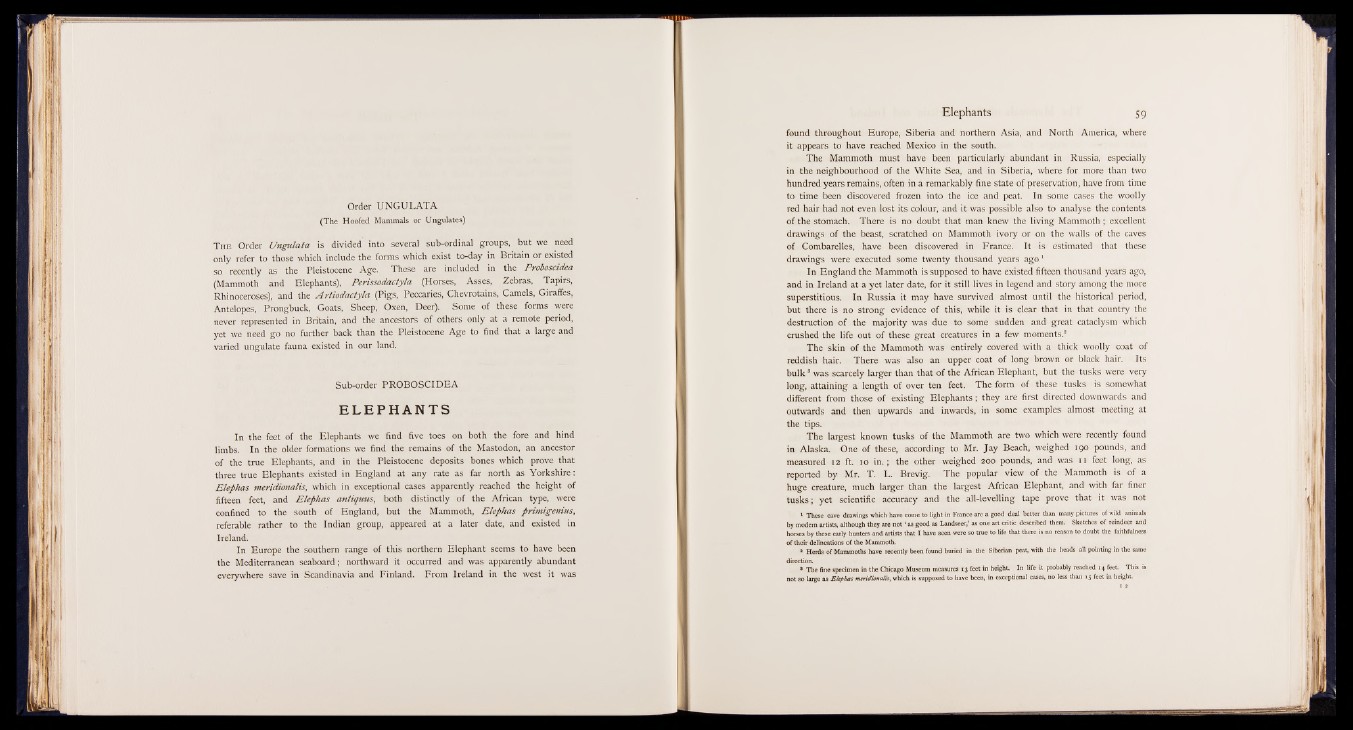
Order UNGULATA
(The Hoofed Mammals or Ungulates)
T he Order Ungulata is divided into several sub-ordinal groups, but we need
only refer to those which include the forms which exist to-day in Britain or existed
so recently as the Pleistocene Age. These are included in the Proboscidea
(Mammoth and Elephants), Perissodactyla (Horses, Asses, Zebras, Tapirs,
Rhinoceroses), and the Artiodactyla (Pigs, Peccaries, Chevrotains, Camels, Giraffes,
Antelopes, Prongbuck, Goats, Sheep, Oxen, Deer). Some of these forms were
never represented in Britain, and the ancestors of others only at a remote period,
yet we need go no further back than the Pleistocene Age to find that a large and
varied ungulate fauna existed in our land.
Sub-order PROBOSCIDEA
E L E P H A N T S
In the feet of the Elephants we find five toes on both the fore and hind
limbs. In the older formations we find the remains of the Mastodon, an ancestor
of the true Elephants, and in the Pleistocene deposits bones which prove that
three true Elephants existed in England at any rate as far north as Yorkshire:
Elephas meridionalts, which in exceptional cases apparently reached the height of
fifteen feet, and Elephas antiquus, both distinctly of the African type, were
confined to the south of England, but the Mammoth, Elephas primigenius,
referable rather to the Indian group, appeared at a later date, and existed in
Ireland.
In Europe the southern range of this northern Elephant seems to have been
the Mediterranean seaboard; northward it occurred and was apparently abundant
everywhere save in Scandinavia and Finland. From Ireland in the west it was
Elephants 59
found throughout Europe, Siberia and northern Asia, and North America, where
it appears to have reached Mexico in the south.
The Mammoth must have been particularly abundant in Russia, especially
in the neighbourhood of the White Sea, and in Siberia, where for more than two
hundred years remains, often in a remarkably fine state of preservation, have from time
to time been discovered frozen into the ice and peat. In some cases the woolly
red hair had not even lost its colour, and it was possible also to analyse the contents
of the stomach. There is no doubt that man knew the living Mammoth; excellent
drawings of the beast, scratched on Mammoth ivory or on the walls of the caves
of Combarelles, have been discovered in France. It is estimated that these
drawings were executed some twenty thousand years ago.1
In England the Mammoth is supposed to have existed fifteen thousand years ago,
and in Ireland at a yet later date, for it still lives in legend and story among the more
superstitious. In Russia it may have survived almost until the historical period,
but there is no strong evidence of this, while it is clear that in that country the
destruction of the majority was due to some sudden and great cataclysm which
crushed the life out of these great creatures in a few moments.2
The skin of the Mammoth was entirely covered with a thick woolly coat of
reddish hair. There was also an upper coat of long brown or black hair. Its
bulk8 was scarcely larger than that of the African Elephant, but the tusks were very
long, attaining a length of over ten feet. The form of these tusks is somewhat
different from those of existing Elephants; they are first directed downwards and
outwards and then upwards and inwards, in some examples almost meeting at
the tips.
The largest known tusks of the Mammoth are two which were recently found
in Alaska. One of these, according to Mr. Jay Beach, weighed 190 pounds, and
measured 12 ft. 10 in.; the other weighed 200 pounds, and was 11 feet long, as
reported by Mr. T. L. Brevig. The popular view of the Mammoth is of a
huge creature, much larger than the largest African Elephant, and with far finer
tusks; yet scientific accuracy and the all-levelling tape prove that it was not
1 These cave drawings which have come to light in France are a good deal better than many pictures of wild animals
by modem artists, although they are n o t' as good as Landseer,’ as one art critic described them. Sketches of reindeer and
horses by these early hunters and artists that I have seen were so true to life that there is no reason to doubt the faithfulness
of their delineations of the Mammoth.
* Herds of Mammoths have recently been found buried in thé Siberian peat, with the heads all pointing in the same
direction.
3 The fine specimen in the Chicago Museum measures 13 feet in height. In life it probably reached 14 feet. This is
not so large as Elephas meridionalts, which is supposed to have been, in exceptional cases, no less than 15 feet in height.